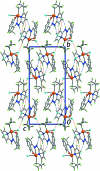n-Butyl-dichlorido(2-{(1E)-1-[2-(pyridin-2-yl)hydrazin-1-yl-idene]eth-yl}phenolato)tin(IV)
- PMID: 21588842
- PMCID: PMC3009310
- DOI: 10.1107/S1600536810040572
n-Butyl-dichlorido(2-{(1E)-1-[2-(pyridin-2-yl)hydrazin-1-yl-idene]eth-yl}phenolato)tin(IV)
Abstract
Two independent mol-ecules comprise the asymmetric unit of the title compound, [Sn(C(4)H(9))(C(13)H(12)N(3)O)Cl(2)]. The Sn atom in each is coordinated by the tridentate ligand via the phenoxide O, hydrazine N and pyridyl N atoms, forming five- and six-membered chelate rings. The approximately octa-hedral coordination geometry is completed by the α-C atom of the n-butyl group (which is trans to the hydrazine N atom) and two mutually trans Cl atoms. Differences between the mol-ecules are evident in the relative planarity of the chelate rings and in the conformations of the n-butyl groups [C-C-C-C = 177.2 (5) and -64.4 (11)°]. Significant differences in the Sn-Cl bond lengths are related to the formation of N-H⋯Cl hydrogen bonds, which link the mol-ecules comprising the asymmetric unit into dimeric aggregates. These are consolidated in the crystal packing by C-H⋯Cl contacts. The structure was refined as an inversion twin; the minor twin component is 37 (3)%.
Figures



References
-
- Affan, M. A., Foo, I. P. P., Fasihuddin, B. A. & Hapipah, M. A. (2009). Ind. J. Chem. Sect. A, 48, 1388–1393.
-
- Brandenburg, K. (2006). DIAMOND Crystal Impact GbR, Bonn, Germany.
-
- Bruker (2008). APEX2 and SAINT Bruker AXS Inc., Madison, Wisconsin, USA.
-
- Farrugia, L. J. (1997). J. Appl. Cryst.30, 565.
-
- Flack, H. D. (1983). Acta Cryst. A39, 876–881.
LinkOut - more resources
Full Text Sources
